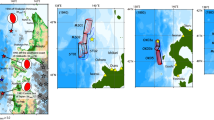Abstract
Broadband receiver functions abstracted from teleseismicP waveforms recorded by a 3-component Streckeisen seismograph at Hyderabad, have been inverted to constrain the shear velocity structure of the underlying crust. Receiver functions obtained from the Hyderabad records of both shallow and intermediate focus earthquakes lying in different station-event azimuths, show a remarkable coherence in arrival times and shapes of the significant shear wave phases:Ps, PpPs, PsPs/PpSs, indicating horizontal stratification within the limits of resolution. This is also supported by the relatively small observed amplitudes of the tangential component receiver functions which are less than 10% of the corresponding radial component. Results of several hundred inversions of stacked receiver functions from closely clustered events (within 2°), show that the crust beneath the Hyderabad granites has a thickness of 36 ± 1 km, consisting of a 10 km thick top layer in which shear wave velocity is 3.54 ± 0.07 km/sec, underlain by a 26 ± 1 km thick lower crust in which the shear wave velocity varies uniformly with a small gradient of 0.02 km/sec/km. The shear wave velocity at its base is 4.1 ± 0.05 km/sec, just above the moho transition zone which is constrained to be less than 4 km thick, overlying a 4.74 ±0.1 km/sec half space.
Similar content being viewed by others
References
Ammon C J, Randall G E and Zandt G 1990 On the nonuniqueness of receiver function inversions;J. Geophys. Res. 95 15303–15318
Ammon C J 1991 The isolation of receiver effects from teleseismicP waveforms;Bull. Seism. Soc. Am. 6 2504–10
Clayton R W and Wiggins R A 1976 Source shape estimation and deconvolution of teleseismic body waves;Geophys. J. R. Astr. Soc. 47 151–177
Gurrolla H, Eli Baker G and Minister J B 1995 Simultaneous time-domain deconvolution with application to receiver function analysis;Geophys. J. Int. 120 537–543
Langston C A 1979 Structure under Mount Rainier, Washington, inferred from teleseismic body waves;J. Geophys. Res. 84 4749–62
Menke W 1989 Geophysical data analysis: Discrete inverse theory (Acad. Press Inc.)
Owens T J, Zandt G and Taylor S R 1984 Seismic evidence for an ancient rift beneath the Cumberland plateau, Tennessee;J. Geophys. Res. 89 7783–95
Randall G E and Owens T J 1994 Array analysis of the largeaperture array of the 1988–89 PASSCAL Basin and range passive source seismic experiment;J. Geophys. Res. 116 618–36
Rai S S, Sarma P V S S R, Prakasam K S and Rao V K 1996 Seismic evidence for thick and underplated late Archaean crust of eastern Dharwar craton;Proc. Indian Acad. Sci. (Earth Planet. Sci.) 105 431–439
Sarvothaman H and Leelanandam C 1987 Petrography and major oxide chemistry of the Archaean granitic rocks of the Medak area, Andhra Pradesh;J. Geol. Soc. India 30 194–209
Author information
Authors and Affiliations
Rights and permissions
About this article
Cite this article
Gaur, V.K., Priestley, K.F. Shear wave velocity structure beneath the Archaean granites around Hyderabad, inferred from receiver function analysis. Proc. Indian Acad. Sci. (Earth Planet Sci.) 106, 1–8 (1997). https://doi.org/10.1007/BF02841745
Received:
Revised:
Published:
Issue Date:
DOI: https://doi.org/10.1007/BF02841745




